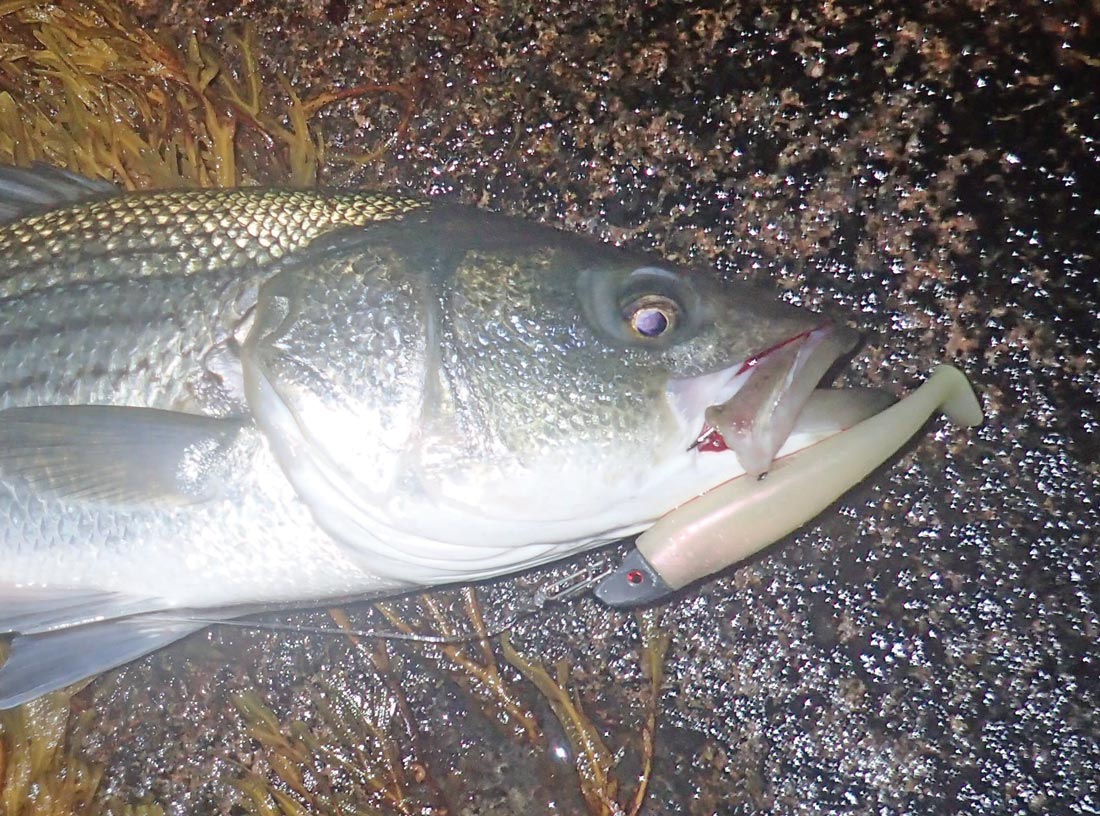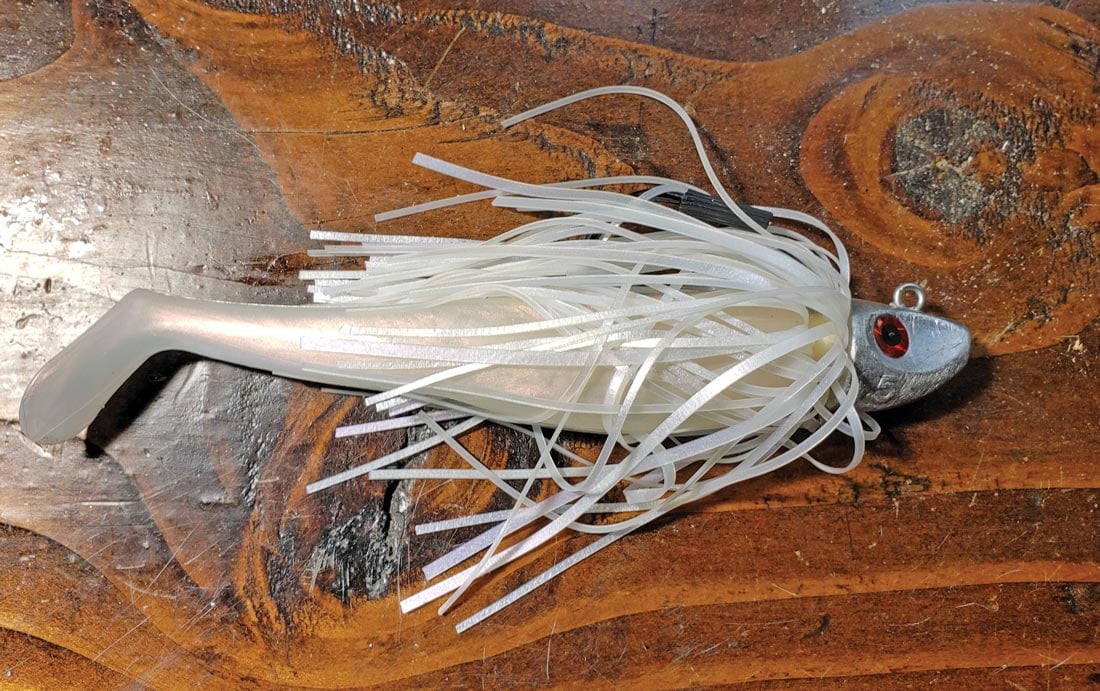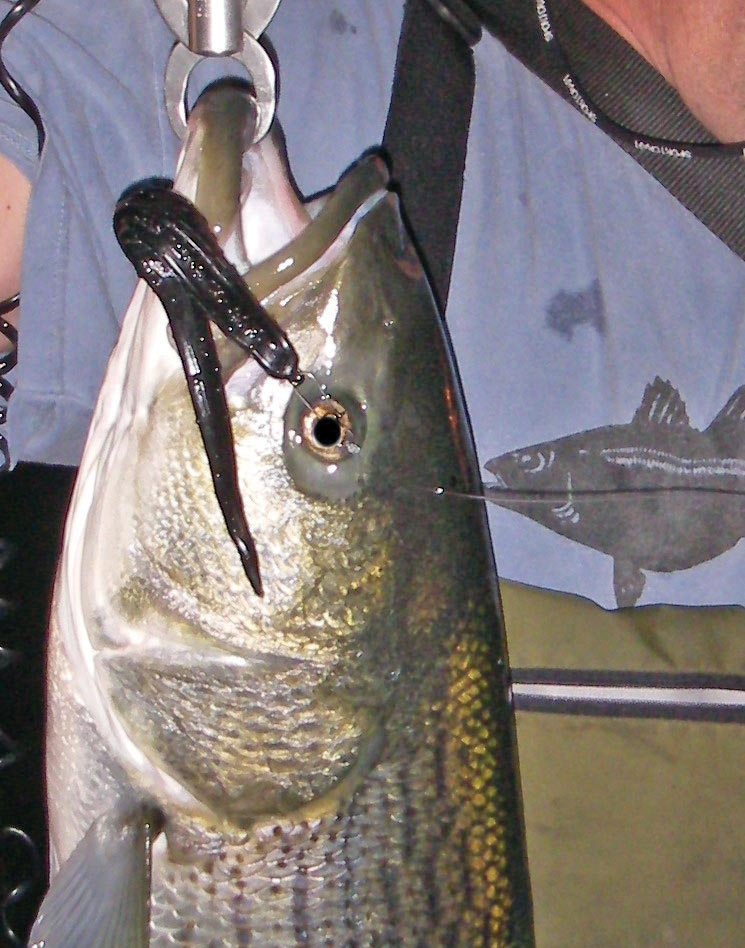
Soft plastics – rubber baits – just as important when stripering!
Hutch and I stood talking at one of the winter shows; he is fascinating to talk to and he has always pulled good stuff out of my head and taught me how to organize my thoughts when it came to writing about fishing. We were discussing a couple of things including rubbers and leadheads.
As we talked about some different types and specific techniques, I thought back on my rubbah pilgrimage. If I had to put a finger on it somewhere I would say that when Steve McKenna started banging big bass on the rigged Slug-Gos it got my attention. I was throwing snakes for large fish and Steve was banging legit linesiders on rubber. He had my interest.
The Evolution Begins
I started with the rigged Slug-Go and soon found that a bass could in no way swim past one without gulping it. That is a very good thing if you like catching stripers. The problem I started having was that when the conditions weren’t optimal for the rigged Slug-Go (relative flat with mild wind) it had to go bye-bye. So I needed a change; I needed to be able to use the rubber even when conditions weren’t optimal for the rigged Slug-Go; enter the leadhead.

I took the Slug-Go and snipped the nose off it then glued it onto a leadhead and bang! I had a good casting lure that also penetrated the depths, not like the rigged version, which stayed high in the column. My success was beautiful. If you cast the lure and watched as it swam back in you quickly realized why bass loved it so much.
It was from this that I really started going into the rubber-leadhead world as it gave me everything I needed. But let me back up a bit. I’ll never forget the day I walked into Captain Bill’s Bait and Tackle in Neptune City and Bobby Matthews showed me a new “item” it was called a paddletail shad. A rubber paddletail with the weight built in (that was the new part).
The first package I saw was a Panther Martin, that one was soon followed by others, Calcutta, then Storm and then Tsunami and more flooded the market. I was honestly repulsed by the notion of this funny looking newbie to the surf community and I swore (like the big dummy that I am) that “I will never use that thing!” That was until somebody whispered something about how many fish they were taking with it that I actually gave it a shot and I never looked back.
That shad quickly became a favorite of mine and I found it extremely effective and productive out fishing my hard plastic and metal-lip swimmers.
The Glory Days
Then came the days of abundance and big bass; in the early 2000s monster stripers were all over the place, they were readily available and catching them was doable provided you were of course in the right place at the right time and cast the correct offering. While eels were the staple and the pathway to large, they were and still are a pain to deal with especially when you are on a rock, you are wet, it’s nighttime and your eel bag has a hole in it. I started using some nicely profiled, hearty, rubber baits with a leadhead and soon found that I was able to catch the same good fish on rubber that I could get on eels. I fell deeper in love with using the rubber-leadhead combination.
On this one particular 9-inch rubber bait I caught plenty of big bass and of course smaller bass also found it to their liking. This bait swam so sexy and ‘snakey’ the bass would crush it. I caught hundreds of fish on that bait!
Lunker City’s Slug-Go soft plastic bait was created by Connecticut angler Herb Reed who began working on his weedless design for freshwater bass fishing in the early 1980s. Reed’s Slug-Go bait first appeared around 1988 and was quickly embraced in the freshwater market.
“It looks like a slug but it acts like an injured baitfish,” Reed told writer Tom Fegely at The Morning Call newspaper in Allentown back in 1991, adding “I always had a problem with hard stick baits and minnow-imitators with treble hooks in heavy cover.” Thus, the name Slug-Go came about from its actual resemblance to a slug.
“Lures like this were non-existent until the Slug-Go,” Reed said in The Morning Call interview 29 years ago, adding “It can be applied to many situations.” Like striped bass fishing in the salt!

Then came the dark ages (present) where the big bass were harder to come by, the medium-sized bass were absent, and little bass did their best to fill the cracks and crevasses. I found myself doing a hell of a lot more work for fewer and smaller fish. My rate of work increased quite a bit while my rate of catch really dropped off as did my size.
Let’s get technical for a moment. My buddy used to always say water is a solid; no he was not talking about ice either. He said if something moves through the water and the water moves a half-inch or an inch it creates movement and “feeling” for the lack of a better word, there has to be displacement as water is moved. Similar to what ripples do on the surface of the water but only below, this would explain why a fish can find a fly, no sound, no commotion, just water displacement, even if on a very small scale (Flies are relatively small.).
I always thought, you have two fish one on one side of a school, one on the other side of a school with one thousand other fish in between, how do they both turn in the same direction instantly? It’s the lateral line that feels vibration and detects movement-instantly, if not faster. (Watch Blue Planet from BBC/Discovery sometime and study the bait schools as they swim.) The bait schools move in unison. Our predatory fish, all predatory fish, feed based on feel, they only use sight when within 2 to 3 feet of the prey. I like to say that they “feel” similar to the way we see, yes that good.
So as fishing has become tougher, I have had to compensate or get smarter in order to keep my rate of catch up. So to do so I ditched my long skinny offerings for they were too “quiet” in the water, too sleek. I reverted back to my old friend the paddletail.
As I studied it more closely, when I fished a paddletail the vibration that came through the rod was obvious. And in the last couple of years I have been able to keep catching fish, not great like the days of yesteryear but well enough to keep my interest in a changing fishery with a sometimes uncertain future.


